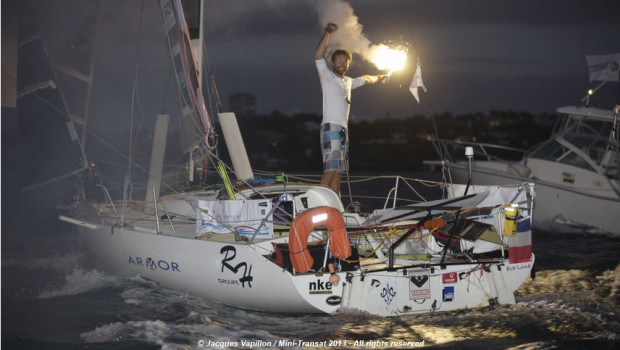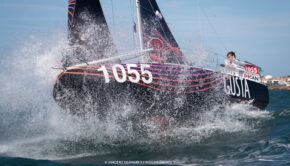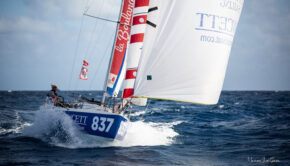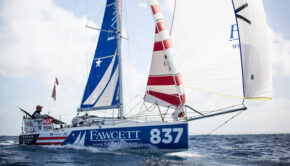Mini Transat – Little Boat, Big Pond
Published on December 4th, 2013
By Bruce Gain, Sailing World
Just finishing the Mini Transat is a major feat for any sailor who dares brave the hell and fury the Atlantic Ocean can unleash on such a small boat. At the very least, surviving the trek invariably means getting beaten and tossed around for weeks on a 6.50-meter boat that merits its “Mini” name.
The singular focus of just making it to the tropical waters of Guadeloupe by way of the Atlantic after leaving gray and cold Brittany, France, behind was certainly amateur sailor Benoit Marie’s goal. But as a surprise to himself, as well as those who follow the race, he arrived to port first, ahead of some of the world’s best Mini sailors.
Marie certainly paid his dues along the way. He was knocked unconscious when he fell in the cockpit, alone in the middle of the Atlantic. His boat broached several times. Like the rest of the fleet during the first leg between France and Spain, he had to steer his boat in 40-knot winds and 12-foot waves.
So how did this relatively inexperienced sailor accomplish what he did? It was a question of sailing fast yet safe, Marie says.
Bruce Gain: It seemed that the trek was pleasant after leaving Sada?
Benoit Marie: We had the wind blowing behind the whole way. We had very strong winds at the beginning, lighter winds in the middle, and then we got more of the strong winds again. Having the wind behind us like that was something I never would have thought would have been possible.
How much of the time did you keep your spinnaker up?
My big spinnaker was up most of the time during the second part of the race. I also sailed “butterfly” at an angle to the wind of 150 to 180 degrees. Sure, I did a few forced jibes, which was pretty crazy. I woke up a few times with the mast on the wrong side of the boat.
You were not among the favorites to finish first. What perceived weaknesses did you overcome to sail to Guadeloupe first?
My boat’s Proto design really likes to sail downwind. I knew it was a fast boat. I was very motivated before and during the race. It was full steam ahead all of the way.
When I got to the middle of the Atlantic Ocean, I wrote down in my journal that I no longer had an [inferiority] complex about anything and that there was no reason why I couldn’t win this race.
Consider Bertrand Delesne, who was probably the most skilled and experienced sailor in the Mini fleet and others who have a really high level of skill and sailing experience. Comparatively, I only have a year and a half of Mini Class sailing experience. I could have easily had an inferiority complex of being the rookie. But I eventually learned that I could sail as well as anybody in the fleet.
You spoke of some dark and lonely nights during the race. What were some of the most challenging moments you had to face?
Read on: http://www.sailingworld.com/blogs/racing/little-boat-big-pond
Background: The biennial Mini Transat is a transatlantic race for solo Mini 6.5m competitors. The race has two legs: 1257 miles from France to Canary Islands, and 2764 miles from Canary Islands to Guadeloupe. Demand is high to compete. The race is limited to 84 racers, and each entrant must fulfill qualifying requirements. The race has a production division and a prototype division.
The start from Douarnenez was originally planned for October 13, but was postponed due to severe weather conditions on the race course. A weather window allowed for the start of the first leg of the Mini Transat 2013 on October 29, but worsening weather conditions forced the cancellation of this leg and the Mini Transat fleet found shelter in the ports on the north coast of Spain.
Seventy-three competitors restarted in Sada, Spain on November 13, with the race reduced to one 3700 mile leg direct to Pointe-à-Pitre, with a gate at the Canary Islands for safety.
Race website: http://www.minitransat.fr/








 We’ll keep your information safe.
We’ll keep your information safe.